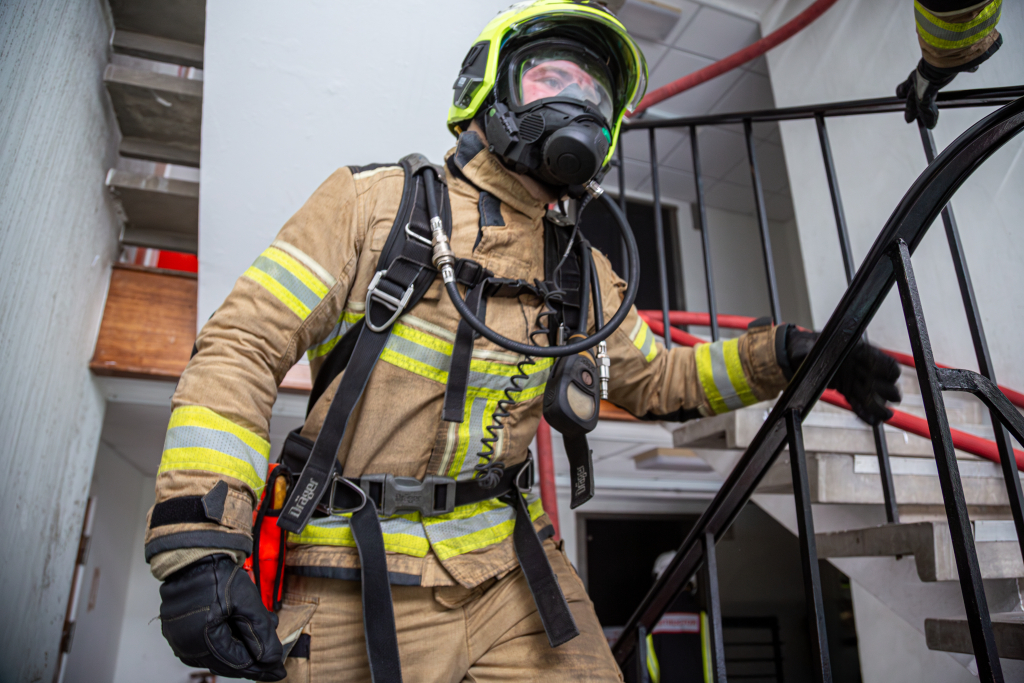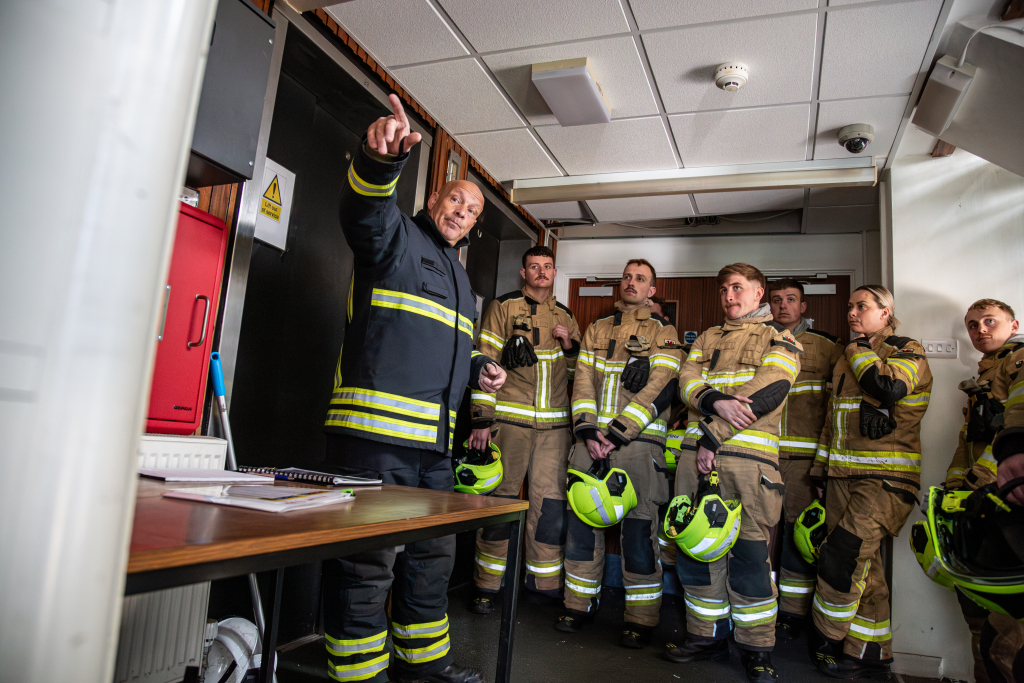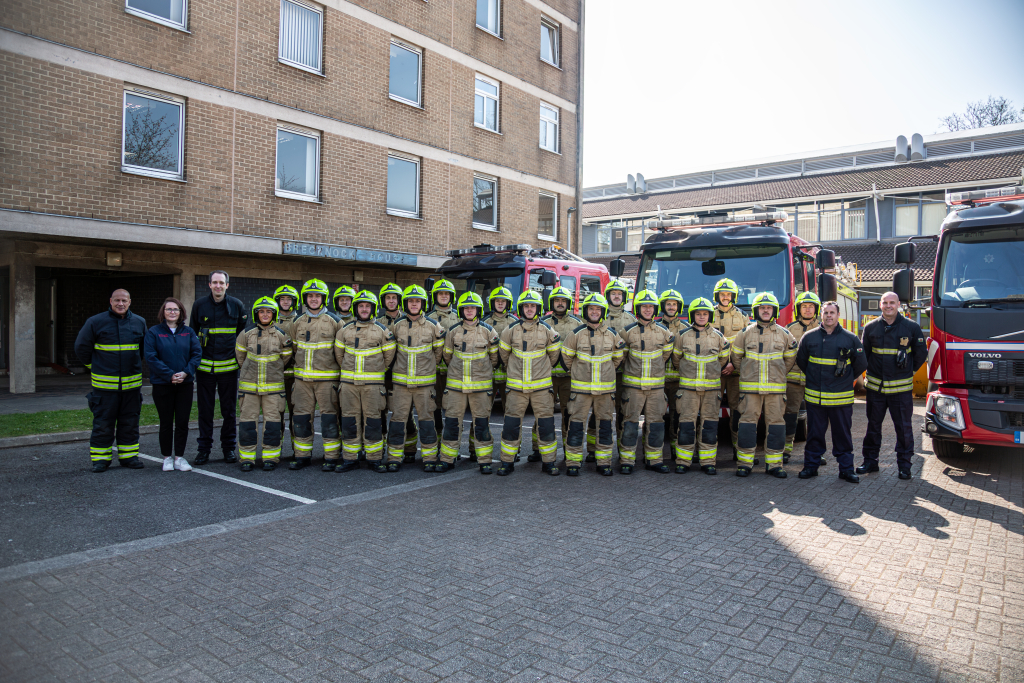High-Rise Task Force Runs Valuable Training for Recruits
South Wales Fire and Rescue Service recently established a full-time High-Rise Task Force in response to recommendations made in Thematic Reviews and Grenfell Phase One and Two Reports. The team has focused its work so far on building a more robust response to high-rise rescue operations – with evacuation, planning, and familiarisation plans being implemented.
Team Lead, Area Manager Mike Wyatt, said: “The task force has been put together to ensure we meet our high-rise recommendation targets, but it goes much further than that.”
“The team and I share the ambition of being pioneers in evacuation protocols and high-rise training, and want to equip our staff with the knowledge, skills and equipment to be ready for some of our most challenging incidents.”

Last year, the High-Rise Task Force delivered 29 high-rise training sessions at their Brecknock House venue, a high-rise building loaned to the service by Cardiff and Vale University Health Board. The training received 4.9 out of 5-star feedback from our staff who expressed their appreciation for the workshop-style sessions on the core skills of high-rise firefighting and introduction to emergency evacuation. The team has built phases of training for all crews, commanders, and Control Room Operators, covering every aspect of high-rise firefighting and evacuation. In addition, continual professional development training has been put in place for all incident commanders, which includes familiarisation, refreshers and incident training.
Phase one is completed, with all wholetime crews and TAC managers now fully trained. Phase two began in April this year, and involves training for all on-call crews, concentrating on building construction and failure, along with evacuation procedures. Building construction is a crucial aspect of high-rise firefighting, as it can dictate how fast a fire will spread, what safety measures are in place, and which methods to deploy for evacuation. Failure of buildings is also a critical topic, as firefighters may have to deal with worst-case scenarios where safety mechanisms (such as fire doors, elevator shut-offs or alarms) don’t work.
In part, training will deploy immersive 360° technologies, including virtual simulations. Here, trainees’ decision-making and skills can be tested with different scenarios which can be changed on-the-fly by an instructor. This training uses a computer-generated scenario which offers the chance to run simulated incidents to allow for guided practice and learning of incident management. This virtual learning is being delivered in combination with the on-site training, which provides familiarity and real-world practice. This year, the team have been building on their training packages, with more interactive sessions and workshops on equipment, understanding high-rise construction, firefighting systems and evacuation methods.

Recent recruits were given high-rise training during their initial 14-week training. Station Manager (SM), Kieran Williams, commented: “It’s a really good opportunity for the new recruits to have an insight into high-rise firefighting. We’re in the process of introducing new high-rise procedures, and they’re able to access them from the earliest part of their career, so they’re prepared and ready for station.”
The training day gave recruits the chance for hands-on learning in an authentic environment, which is invaluable for practising skills. The recruits had a morning of familiarisation, learning about evacuation techniques, as well as high-rise specific challenges and methods. They then applied the skills to a simulated high-rise fire in a block of flats, complete with smoke and weighted dummies representing ‘residents’.
Recruit, Adrienne Foster, who is a former 999 Control Operator for the service, said, “It’s been really interesting and quite demanding. The training is going to be useful. With the increase in high-rise buildings, especially in city centres, it’s really important that every recruit knows what to do. Even if you’re in a Valleys station, if you go on loan to another station, you’re going to have to know this stuff.”
Commissioner Kirsty Williams, CBE, was present at the training and said, “We know that high-rise buildings are some of the biggest risks that we as a service must deal with, and it’s been wonderful to see how the high-rise team is training our new recruits. It’s a highly complex situation that high-rise presents for us, and we know the devastating consequences for our staff and the public if we don’t get it right. So, it’s been really impressive to see the training.”
“We’re very lucky to have this facility lent to us by the local health board. It’s given me a great deal of assurance, having seen it myself. I know what the service is doing to make sure our staff have the skills to respond and to keep our local population safe.”

Both SM Kieran Williams and fellow task force trainer SM Jason Lamport are members of the National Fire Chiefs Council – Fires in Tall Buildings Group, which advises on national policy and procedures. As part of their ongoing work, the High-Rise Task Force is in discussions with members of the Welsh Government to help guide policy and legislative changes affecting those responsible for managing, maintaining, and ensuring fire safety in high-rise buildings.
SM Lamport commented: “The world of high-rise firefighting is changing as quickly as the buildings around us. Equipment and tactics are evolving, and we want to ensure our crews, commanders and control room staff are ahead of the curve. But it is also vital we work alongside our Business Fire Safety and Community Safety colleagues to build a single strategic plan for our landlords and residents.”
He added: “The investment in the task force shows how serious the Commissioners, CFO and Senior Leadership Team are about the progress of high-rise firefighting in South Wales. We look forward to meeting the challenge and seeing you all at Cardiff Gate and Brecknock House. We are determined to take high-rise firefighting training to the next level and ensure you and our communities are safe, confident and prepared.”
To find out more about high-rise living, and how you can keep safe, click here.